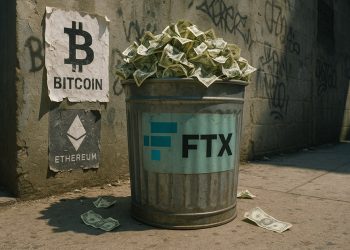I’m one of those scrappy entrepreneurs you see on Kickstarter and Shark Tank. Eleven years ago, shortly after starting a new job that was a bad fit, I had a life-changing encounter with a pair of pan-seared duck breasts. The first created a cataclysmic mess of my stovetop. The second, a few weeks later, inspired me to pre-emptively wrap my skillet in aluminum foil and create an improvised conical splatter shield. By the end of the following year, the Frywall was selling online and in stores.
The new tariffs on imports from China and Taiwan (and the threat of additional Chinese tariffs) are a kick in the teeth for my small family-run business, compelling me to raise my prices even as my profits are slashed. The government’s promise to re-shore the production of simple items like mine looks, from where I sit, like something of a fever dream.
If you ever decide to start a product in the home-goods space, here’s an ironclad rule: Make sure the cost of making your product, including shipping and import charges, is 20 percent to 25 percent of your retail price. If those costs are less, consider lowering your sale price. If your production cost is higher than 25 percent of the manufacturer’s suggested retail price, running your business will feel like climbing a greased pole.
You’ll struggle to afford the 50 percent wholesale discount that retailers expect. And you won’t have the money to fund Amazon fees, advertising, overhead, warehouse space, “free shipping,” legal costs, inventory growth and new product development. My invention emerged from the aha moment with the duck breast; as a company, it would spark to life only if and when I found a way to produce it for $5, and thereby sell it for $25.
Asian suppliers quickly emerged as my only option. I found that silicone products made in the United States were largely low-volume, high-value components for industrial or medical applications. The most competitive U.S. quotes were around $20 per unit, which would have meant retailing at $80. I fantasize about a world where splatter guards sell for $80. It doesn’t exist.
The price discrepancy extended to my first-year start-up investment in molds. What cost me $18,000 in Taiwan would have set me back $120,000 in the United States, a figure to make an untested entrepreneur with an untested product retreat to his desk job.
When you hear of an American company making a product abroad for $5, it sounds like America is sending money away and just getting a doodad in return. In reality, that $5 buys us a product plus the fuel to power $20 of domestic economic activity.
Because the $20 gap between my manufacturing cost and my sale price flows to Americans, American companies and other American entities: to the Amazon warehouse workers and delivery people I help fund through my Amazon seller fees; to Peter, my U.S. Postal Service parcel carrier; to software platforms, like Google, Intuit and ShipStation, which I use to run my business; to the freelance designer working with me on a new product; to the lawyers who protect my patents and trademarks; to my advertising and marketing partners; to the coffers of the U.S. Treasury, New York State and New York City; and, hopefully in the end, also to me and my family. It seems an awful waste to torch $20 of domestic economic activity to get at $5 more.
So here’s how my business pencils out after last week’s tariff sucker punch. The cost to manufacture my product in China and ship it to America has gone from my average landed cost (total product price, plus overseas freight plus total import costs) of about $5 to about $7.50. To stay within the healthy ratio I cited requires raising the average selling price by at least $5, to $30 from $25.
A 20 percent price increase is one that threatens to sling this product from the realm of “a little expensive but worth it” to the land of “are you nuts?” The danger seems particularly acute as prices for basic goods, such as food and clothing, rise and chew into consumers’ discretionary budgets.
While the thought of raising prices roils my innards, my next shipment from Asia arrives next month and will already bear the extra tariff costs. I’d love to hold off on a decision — maybe the tariffs will get negotiated away — but some of my retail partners require three months’ notice for price changes. Every day I wait pushes my price reset date deeper into July.
Bizarrely, the U.S. government can scramble its tariff policy faster and with less warning than I can change my retail prices. I face a critical business decision and lack the minimal level of certainty to make it.
These factors are also upending my plans for a new product launch later this year. With the new tariffs, that product’s retail price will land 30 percent higher than planned, kneecapping its likelihood of success.
Odds are now even that I will slow things down for a while, to see what happens. That would mean icing the pending engagement of an American patent lawyer, an American public relations firm and an American freelance designer. Sadly for me, it would also mean delaying indefinitely the delight of bringing a new product into the world, which is my overriding motivation.
Some commentators would have you believe that importers can cushion the blow of higher tariffs by negotiating lower prices with their suppliers. This is an alluring idea born of ignorance and divorced from reality. Factories in Asia run single-digit profit margins. In no universe can they absorb a meaningful share of tariff costs, at least not without drastically devaluing their currency or making ruinous sacrifices to production quality. Make no mistake: Tariff costs are paid for by consumers in the form of higher prices and by companies in the form of diminished margins and slower sales.
My other option is to onshore production. I hope this will be possible one day. But creating an entire supply chain ex nihilo is complicated, even for a simple product like mine. Standing up new contract manufacturers would most likely be the easiest part. More complicated by far is building new chemical plants to make the right kind of silicone and new factories to manufacture molds, mold-making equipment, presses and robotics to reduce the cost and monotony of the unskilled labor that workers in advanced economies were already happy to ditch a century ago.
None of this is necessarily impossible. But at a minimum, it requires stable policies, enormous investment and attracting foreign engineers and managers with the expertise and experience we haven’t nurtured stateside in generations. This is a matter of years, even in the rosiest of scenarios. Companies like mine may not have that long.
I share many Americans’ nostalgia for a time when we made more stuff here and bought fewer things and they lasted longer. Who knows, there may be a way to return to a version of that economy. But I can’t clock why taking a wrecking ball to small business has to be Step 1.
#Opinion #Invented #Popular #Kitchen #Gadget #Trumps #Tariffs #Kill #Business




















